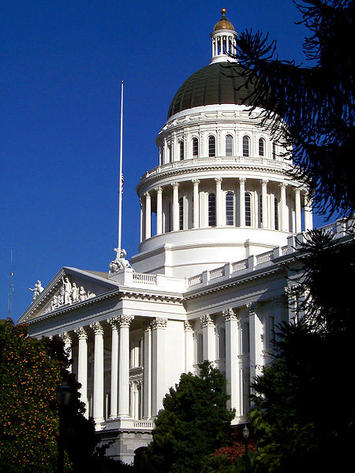
Once upon a time, the California Republican Party was a fearsome political instrument, forging the ground for two presidents. But today the California GOP is fighting rearguard actions to save its last remaining seats in once solidly Republican strongholds as Orange, San Diego and even in inland California, potentially costing them upward of seven House seats.
The party is now so pathetic that a top party official crowed that GOP gubernatorial candidate John Cox might be “within 10 points” to the inevitable winner, Gavin Newsom. No doubt the architects of the earlier glory days like Stuart Spencer, Mike Deaver or Pete Hannaford would find this situation unbearable.
What California needs is not a new Republican Party — at least at the state level — but what the late Kevin Starr called “the Party of California.” This party would target the growing independent constituency, now larger than Republicans, as well as Democrats who might be disaffected by their party’s relentless move to the left.
Roots of a one-party state
The roots of the Republican collapse lie largely in demographics: the steady loss of middle-class, middle-aged families, and the massive immigration of the 1980s and 1990s, which shifted the state’s ethnic profile. In 2012, the California electorate was barely half non-Latino white, but by 2030 it will drop closer to 40 percent. Some Republicans, including strong Asian-American candidates in Orange County, have made some breakthrough but overall this is ever more the party of aging white males.
Economic changes have also played a role. California’s growth engine now rests almost entirely on tech oligarchs, large funders and, increasingly, media enforcers for the progressive agenda — at least as far as it does not threaten their vast wealth. The parts of the California economy that once backed the GOP, such as aerospace, oil and gas and suburban homebuilding, have fallen into a long-term secular decline.
Much of the media, and virtually all progressive activists, will consider the collapse of the GOP as a positive development. Yet for Californians as a whole, one-party rule — as is usually the case — has engendered a growing disconnect between the political elites and the aspirations of electorate.
Time for a Party of California
If we had a functioning two-party system, California’s insane climate jihad — which has served to weaken most blue-collar sectors and boosted energy and home prices — would be reevaluated based on economic impacts as opposed to increasingly stepped up. Gov. Jerry Brown’s high-speed choo-choo would likely be abandoned or scaled back out of sheer embarrassment.
But now California’s Democratic activists face few brakes on their power. They can, and often do, impose whatever controls on people’s lives and thoughts as possible, with little concern with push-back from the impacted masses.
To stop this neo-Stalinist momentum, we need an opposition that does not carry the GOP’s toxic legacy on issues relating to gays, minorities and immigrants. Running a wealthy, carpetbagging, visionless non-entity like John Cox, who speaks mostly to the aging Reagan constituencies, seems a poor way to change perceptions.
What would the Party of California stand for?
This new party should not become some “third way” front for the super-rich and their technocratic approach to politics. It could even take some pages from Trump’s book of economic nationalism and populism, but throw away the arguably xenophobic excesses associated with the chief executive, a very unpopular figure in the state. Instead it would focus heavily on those parts of the state — pretty much everywhere outside Silicon Valley and fashionable coastal communities in Southern California — that have seen little high-wage job growth, and growing poverty under the current regime.
What would a Party of California favor? It would stand for local control, which has support from about 70 percent of voters, according to a new USC Dornsife poll, and oppose the top-down policies favored by the state’s planning clerisy. The party might allow poorer areas, particularly in the interior, to increase their competitiveness by opting out of some of the fashionable progressive lunacy imposed by the Bay Area-dominated political class.
This new party would embrace California’s obligations on the environment, but at a level congruent with policies adopted by most foreign competitors. It would seek ways to employ the very technologies developed here to make our suburbs and rural areas more sustainable. The current policy of “pack and stack,” favored by the planners, means simply higher prices and fewer residences that appeal to families.
There are some promising signs. For all the inevitability of more progressive gains, two candidates, charter school advocate Marshall Tuck for superintendent of education, and tech executive Steve Poizner, running for insurance commissioner with “No Party Preference,” seem likely to either win or get in striking distance.
These candidates, particularly should they win, could pave the way for others to consider running outside the two established parties. The GOP, hopelessly addicted to its declining base, cannot accomplish this, but an emergent Party of California might do the trick.
This piece originally appeared in The Orange County Register.
Joel Kotkin is executive editor of NewGeography.com. He is the Roger Hobbs Distinguished Fellow in Urban Studies at Chapman University and executive director of the Houston-based Center for Opportunity Urbanism. His newest book is The Human City: Urbanism for the rest of us. He is also author of The New Class Conflict, The City: A Global History, and The Next Hundred Million: America in 2050. He lives in Orange County, CA.
Photo: SCUMATT [GFDL or CC-BY-SA-3.0], via Wikimedia Commons












